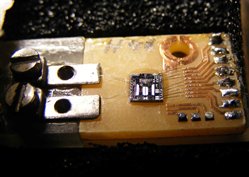Biodiagnostics
The Biodiagnostics group expands our strong interest in developing new instrumentation, working on new Nuclear Magnetic Resonance and THz detectors for applications in biological and medical diagnostics.
Low field NMR and MRI
Nuclear magnetic resonance (NMR) plays an important role in medical research, from spectroscopic analysis to magnetic resonance imaging (MRI). At Royal Holloway we are using Superconducting Quantum Interference Devices (SQUIDs) as ultra-sensitive amplifiers in NMR spectrometers. SQUIDs are presently the most sensitive detectors of magnetic flux available and as such they enable the development of NMR systems with unprecedented signal sensitivity.
We use the most sensitive SQUIDs currently available, obtained through a collaboration with Physikalisch-Technische Bundesanstalt (PTB) in Berlin.
We originally developed SQUID NMR spectrometers for the study of weakly magnetic systems at cryogenic temperatures. More recently we have been applying them to samples at room temperature in order to allow the investigation of biomedical samples. Here the technical advances in NMR that we have achieved can be used for the advancement of medical science.

The use of SQUIDs as detectors for MRI can in principle provide high sensitivity at low magnetic fields and offer the possibility of a low cost portable imager. There can be additional benefits from operating at low magnetic fields. For example it is easier to distinguish between normal and cancerous tissue by making NMR measurements in low magnetic fields. SQUID spectrometers could be useful therefore for biopsies. Another potential use of a low field SQUID NMR system is the imaging of neuronal currents in the Brain with high spatial and temporal resolution – something that is presently impossible using a single experimental technique.
Since the SQUIDs we use need to be operated close to 4.2 K there are technical difficulties associated with measurements on room temperature samples. Our work up to now has focused on immersing the SQUID and sample into liquid helium, but with the sample contained in a vacuum chamber and kept at room temperature with a heater. We have used this system to measure the NMR properties of solutions of magnetic nanoparticles in order to investigate the potential for using nanoparticle as contrast agents in low field MRI.
Since the fields measured by the SQUIDs are extremely small (and can be as low as of the Earth’s magnetic field) very careful magnetic screening is required. In the group we have a magnetically screened room constructed from a high-magnetic permeability material called mu-metal, in which to carry out the experiments.
Terahertz imaging for health screening
We are committed in developing an innovative nanotechnology-based sensor for sub-terahertz radiation, that will be integrated in a 2D imaging system enabling the spectroscopic study of tissues and thus early and more accurate diagnosis of tumors and other diseases. The challenge is to support the biochemical analysis of slides, currently done mainly by pathologists on an empirical basis, providing a visual evidence of differences between healthy and diseased tissues provided by a compact two dimensional ex-vivo imaging system.
The proposed imaging technology is based on breakthroughs in fundamental research, an application of low dimensional semiconductor hetero-structures to detection and manipulation of THz radiation, recently made by researchers of the nanophysics group at Royal Holloway in collaboration with Tokyo University and ISSP RAN (Russia).